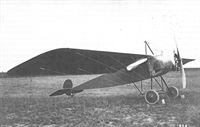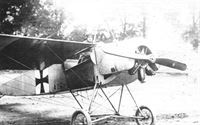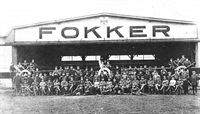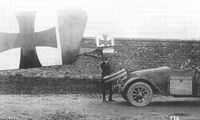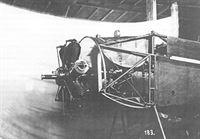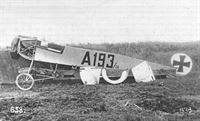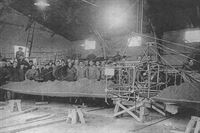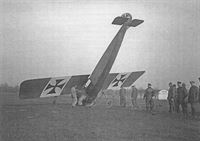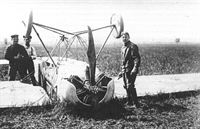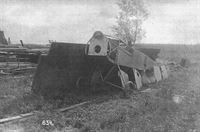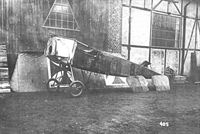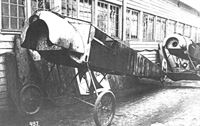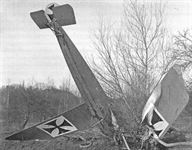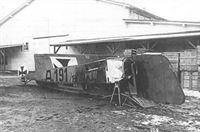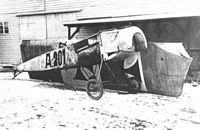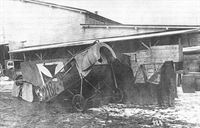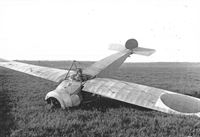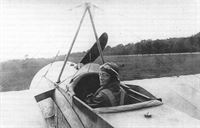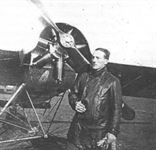Книги
Centennial Perspective
J.Herris
Fokker Aircraft of WWI. Vol.1: Spinne - M.10 & Watercraft
322
J.Herris - Fokker Aircraft of WWI. Vol.1: Spinne - M.10 & Watercraft /Centennial Perspective/ (51)
Fokker co-designed and built this first aircraft. It was basically a copy of a Farman aircraft built by Fokker and others at the Automobilfachschule Mainz. It was destroyed by his partner in a flying accident.
Fokker Spinne
After Bruno Buechner, Fokker's associate, destroyed the first airplane Fokker had helped build, Fokker started his first completely original design. Due to its extensive wire bracing, Fokker called this first design Spinne (Spider).
The Spinne was a monoplane with flat horizontal tail and no vertical fin nor rudder. It was power by a 50 hp Argus engine cooled by side radiators. The monoplane wings had steel tubing framework, were swept back, and had significant dihedral for natural stability. Roll control was by wing warping. The 'fuselage' was formed of two wood longerons with wood cross braces that the engine was attached to. The pilot's seat was directly behind the engine. The general configuration was based on model gliders that Fokker had built.
For this first original design, Fokker was in partnership with Franc von Daum, who provided funding for the engine and contributed to building it. During Fokker's test hops with the machine a number of changes were made. To improve controllability a movable elevator was added, then a vertical rudder. However, when Fokker went home to Amsterdam for Christmas 1910, von Daum, who had been prevented from trying the aircraft, attempted to fly it and crashed into a tree. Spinne I was destroyed but the Argus engine survived.
Fokker then built a second, somewhat more advanced Spinne, using the 50 hp Argus engine from the first. This second Spinne was built in the workshop of Jacob Goedecker, another aviation pioneer who was also a qualified engineer. Goedecker assisted with detail design; however, the second Spinne was closely related to the first. Fokker fitted the second Spinne with ailerons instead of wing warping and fitted a rudder.
Fokker taught himself to fly in this second Spinne. After gaining some flight experience he requested a pilot's certificate, which he was granted on 7 June 1911 after passing the flight test.
As part of their agreement, von Daum was to get ownership of Spinne II as soon as Fokker had gained his flying license, and Fokker was to teach him to fly. Von Daum crashed the second Spinne while flying it. Fokker, meanwhile, had been building a third Spinne at the Goedecker workshop.
After Bruno Buechner, Fokker's associate, destroyed the first airplane Fokker had helped build, Fokker started his first completely original design. Due to its extensive wire bracing, Fokker called this first design Spinne (Spider).
The Spinne was a monoplane with flat horizontal tail and no vertical fin nor rudder. It was power by a 50 hp Argus engine cooled by side radiators. The monoplane wings had steel tubing framework, were swept back, and had significant dihedral for natural stability. Roll control was by wing warping. The 'fuselage' was formed of two wood longerons with wood cross braces that the engine was attached to. The pilot's seat was directly behind the engine. The general configuration was based on model gliders that Fokker had built.
For this first original design, Fokker was in partnership with Franc von Daum, who provided funding for the engine and contributed to building it. During Fokker's test hops with the machine a number of changes were made. To improve controllability a movable elevator was added, then a vertical rudder. However, when Fokker went home to Amsterdam for Christmas 1910, von Daum, who had been prevented from trying the aircraft, attempted to fly it and crashed into a tree. Spinne I was destroyed but the Argus engine survived.
Fokker then built a second, somewhat more advanced Spinne, using the 50 hp Argus engine from the first. This second Spinne was built in the workshop of Jacob Goedecker, another aviation pioneer who was also a qualified engineer. Goedecker assisted with detail design; however, the second Spinne was closely related to the first. Fokker fitted the second Spinne with ailerons instead of wing warping and fitted a rudder.
Fokker taught himself to fly in this second Spinne. After gaining some flight experience he requested a pilot's certificate, which he was granted on 7 June 1911 after passing the flight test.
As part of their agreement, von Daum was to get ownership of Spinne II as soon as Fokker had gained his flying license, and Fokker was to teach him to fly. Von Daum crashed the second Spinne while flying it. Fokker, meanwhile, had been building a third Spinne at the Goedecker workshop.
Fokker Spinne
<...>
Von Daum crashed the second Spinne while flying it. Fokker, meanwhile, had been building a third Spinne at the Goedecker workshop.
Spinne III was to the same basic design as the earlier aircraft, but was smaller and lighter. Despite its smaller size, Fokker built it as a two-seater with pilot in back. Spinne II had proved stable and Fokker built Spinne III with wing warping instead of ailerons.
In 1911 Fokker went to work for Goedecker as a flight instructor. However, in December 1911 he moved to Johannistal, center of Prussian, and thus German aviation, and took Spinne III with him. In January 1912 he gave an impressive flying demonstration in Spinne III during a strong, gusting wind. His success was covered in Berliner Zeitung am Mittag and his reputation as a flyer was made. The next month he registered his company as Fokker Aviatik GmbH, although he never used this name and his company letterhead from the beginning read Fokker Aeroplanbau. Fokker then built a number of Spinne machines that differed little from Spinne III. Some had a 70 hp engine and another a 100 hp engine. Both wood and aluminum nacelles were applied for streamlining, giving these models a distinctive appearance.
Fokker M.1
Fokker had long wanted to sell aircraft to the German Army, and in 1913 he got that opportunity. He received an order for two Spinnen, one powered by a 100 hp Argus engine (A37/13, work number 15) and the other by a new 95 hp Mercedes engine (A38/13, work number 16). The Army had issued a new requirement that all airplanes it purchased have a manufacturer's designation, so Fokker called these Spinnen the M.1, with the 'M' indicating militarisch (military).
The aircraft powered by the Argus engine flew first because that engine was available first. Fokker successfully flew it to 600 m in 9 minutes while carrying enough fuel for a 3 hour flight. On 3 March 1913 it was flown by an Army pilot from Fokker's factory to the test center at Doberitz. Later in March the Mercedes engine was delivered and the second M.1 was completed. Fokker then flew it to Dobertiz.
After evaluating the M.1, the Army decided it was not suitable for demanding military use and did not order any more.
Fokker M.1 Specifications
Engine: 95 hp Mercedes
Wing: Span 13.20 m
General:
Length 8.60 m
Height 3.00 m
Climb: 600m 2 min
<...>
Von Daum crashed the second Spinne while flying it. Fokker, meanwhile, had been building a third Spinne at the Goedecker workshop.
Spinne III was to the same basic design as the earlier aircraft, but was smaller and lighter. Despite its smaller size, Fokker built it as a two-seater with pilot in back. Spinne II had proved stable and Fokker built Spinne III with wing warping instead of ailerons.
In 1911 Fokker went to work for Goedecker as a flight instructor. However, in December 1911 he moved to Johannistal, center of Prussian, and thus German aviation, and took Spinne III with him. In January 1912 he gave an impressive flying demonstration in Spinne III during a strong, gusting wind. His success was covered in Berliner Zeitung am Mittag and his reputation as a flyer was made. The next month he registered his company as Fokker Aviatik GmbH, although he never used this name and his company letterhead from the beginning read Fokker Aeroplanbau. Fokker then built a number of Spinne machines that differed little from Spinne III. Some had a 70 hp engine and another a 100 hp engine. Both wood and aluminum nacelles were applied for streamlining, giving these models a distinctive appearance.
Fokker M.1
Fokker had long wanted to sell aircraft to the German Army, and in 1913 he got that opportunity. He received an order for two Spinnen, one powered by a 100 hp Argus engine (A37/13, work number 15) and the other by a new 95 hp Mercedes engine (A38/13, work number 16). The Army had issued a new requirement that all airplanes it purchased have a manufacturer's designation, so Fokker called these Spinnen the M.1, with the 'M' indicating militarisch (military).
The aircraft powered by the Argus engine flew first because that engine was available first. Fokker successfully flew it to 600 m in 9 minutes while carrying enough fuel for a 3 hour flight. On 3 March 1913 it was flown by an Army pilot from Fokker's factory to the test center at Doberitz. Later in March the Mercedes engine was delivered and the second M.1 was completed. Fokker then flew it to Dobertiz.
After evaluating the M.1, the Army decided it was not suitable for demanding military use and did not order any more.
Fokker M.1 Specifications
Engine: 95 hp Mercedes
Wing: Span 13.20 m
General:
Length 8.60 m
Height 3.00 m
Climb: 600m 2 min
A Fokker Spinne in flight. The under-carriage features nose-over skids. (Peter M. Grosz collection/STDB)
Fokker on his second monoplane, completed in the spring of 1911.
Tony Fokker in his Spinne (Spider), so named due to its many bracing wires. (Peter M. Grosz collection/STDB)
Tony Fokker in his Spinne (Spider), so named due to its many bracing wires. (Peter M. Grosz collection/STDB)
Tony Fokker in his Spinne. The Spinne was the minimum practical flying machine. (Peter M. Grosz collection/STDB)
A pilot in (on?) a Fokker Spinne. Note the early insignia and lack of fuselage covering. (Peter M. Grosz collection/STDB)
The second M.1 wearing its military number A.38/13 on the lower half of its rudder.
The under-carriage had four wheels and nose-over skids. (Peter M. Grosz collection/STDB)
The under-carriage had four wheels and nose-over skids. (Peter M. Grosz collection/STDB)
A Fokker M1 fuselage with streamlined shell over the basic structure. (Peter M. Grosz collection/STDB)
On 13 May 1913 Bernhard de Waal and mechanic Kuntner flew to Holland with an M.1 They demonstrated at Den Haag. This photo taken after arrival at Soesterberg. Bernhard de Waal (*11-04-1892 Arnhem, +28-07-1924 Den Haag (illness)). (Frits Gerdessen collection/STDB)
Fokker M.1 near Tallinn, Estonia, in 1912. Pilot Jan Hilgers stands by his M.1 with his mechanic Hans Schmidt. Johan Wilhelm Emil Louis Hilgers(*Probolingo (Java) 19-12.1886, +Ngawi (Java, Japanese camp) 21-07-1945; FAI pilot's license #4,12-08-1911) was born in the Netherlands East Indies of mixed parentage and died in a Japanese camp just before VJ Day. He made the first flight in Holland by a Dutchman on 29 July 1910. He later joined Fokker and demonstrated Fokker aircraft in Russia. In 1913 he went with two Fokker Spins to the Netherlands East Indies and demonstrated until both were written off. Thereafter he worked as a civilian technician with the NEI air force. (Peter M. Grosz collection/STDB)
Fokker flying his Spinne in a steep turn over Johannisthal in 1912. (Peter M. Grosz collection/STDB)
Fokker M1 Spinne at Korpusnoi near Tsarskoe Selo (near Petrograd) in 1912. Fokker may be in the rear and Lubov Golantschikoff in front but this is not confirmed. (Peter M. Grosz collection/STDB)
Lubov Golantschikoff in the Fokker M1 Spinne in which she set a world record 2,400 m altitude at Johannisthal in November 1912. (Peter M. Grosz collection/STDB)
Fokker M.2
The M.2 was the next Fokker design. Also intended for the Army, it was an attempt to improve performance. The M.1 was sturdy but even Fokker realized that it was not fast. The contemporary Kuhlstein Torpedo had a good reputation as one of the fastest aircraft. Designed by Court and built by Kuhlstein, the aircraft had a streamlined fuselage of circular cross-section, but it was made totally of wood and was heavy.
The Fokker M.2 featured a fuselage of circular cross-section, but the basic square structure, formed of four welded steel tube longerons, was faired into the circular cross-section with light stringers covered with fabric. The wings were made of fabric-covered wood spars and ribs while the tail surfaces were framed with welded steel tube covered with fabric.
The M.2 was powered by a 100 hp Mercedes cooled by two radiators that were curved to fit the fuselage profile.
Fokker entered his M.2 in an August Army competition that required the competitors to be trucked to the test site, assembled there, then flown. Fokker modified the tail surfaces several times to improve flight characteristics. Four examples, A.96-99/13, were ordered.
Because a Rumpler Taube fatally crashed on 4 September, (for the first time), load tests were held at Doberitz with 13 aircraft. Fokker A.99/13 reached the highest factor, 4.5, and the military were duly impressed.
This confirms that A96-99/13 were delivered.
Fokker M.2 Specifications
Engine: 95 hp Mercedes or 100 hp Argus
Wing: Span 13.20 m
General: Length 8.50 m
Max Speed: 100 km/h
The M.2 was the next Fokker design. Also intended for the Army, it was an attempt to improve performance. The M.1 was sturdy but even Fokker realized that it was not fast. The contemporary Kuhlstein Torpedo had a good reputation as one of the fastest aircraft. Designed by Court and built by Kuhlstein, the aircraft had a streamlined fuselage of circular cross-section, but it was made totally of wood and was heavy.
The Fokker M.2 featured a fuselage of circular cross-section, but the basic square structure, formed of four welded steel tube longerons, was faired into the circular cross-section with light stringers covered with fabric. The wings were made of fabric-covered wood spars and ribs while the tail surfaces were framed with welded steel tube covered with fabric.
The M.2 was powered by a 100 hp Mercedes cooled by two radiators that were curved to fit the fuselage profile.
Fokker entered his M.2 in an August Army competition that required the competitors to be trucked to the test site, assembled there, then flown. Fokker modified the tail surfaces several times to improve flight characteristics. Four examples, A.96-99/13, were ordered.
Because a Rumpler Taube fatally crashed on 4 September, (for the first time), load tests were held at Doberitz with 13 aircraft. Fokker A.99/13 reached the highest factor, 4.5, and the military were duly impressed.
This confirms that A96-99/13 were delivered.
Fokker M.2 Specifications
Engine: 95 hp Mercedes or 100 hp Argus
Wing: Span 13.20 m
General: Length 8.50 m
Max Speed: 100 km/h
The Fokker M.2 in its original form (Version 1) with divided elevator and single rudder surface.
The versions differed primarily by the outside of their tail surfaces in an attempt to improve flying qualities. (Peter M. Grosz collection/STDB)
The versions differed primarily by the outside of their tail surfaces in an attempt to improve flying qualities. (Peter M. Grosz collection/STDB)
Version 4 of the M.2 in the 1913 military aircraft competition. Fokker is standing to the right of the airscrew, wearing a scarf.
The M.2 on its transportation Daimler truck as required by the competition. (Peter M. Grosz collection/STDB)
Fokker M.3
The next Fokker design was the M.3, also intended for the Army. Six M.3 aircraft (A.113-118/13, work numbers 28-33) were ordered on 14 June 1913 but the prototype did not meet the requirements for take-off and landing run and the order was cancelled. The M.3 was then used at Fokker's flying school.
Fokker M.3 Specifications
Engine: 95 hp Mercedes
The next Fokker design was the M.3, also intended for the Army. Six M.3 aircraft (A.113-118/13, work numbers 28-33) were ordered on 14 June 1913 but the prototype did not meet the requirements for take-off and landing run and the order was cancelled. The M.3 was then used at Fokker's flying school.
Fokker M.3 Specifications
Engine: 95 hp Mercedes
The Fokker M3 in its second configuration with split rudder; that is, rudders above and below the fuselage. (Peter M. Grosz collection/STDB)
Fokker M.4
The M.4, work number 34, was the next Fokker design and was significantly different that his previous designs. Powered by a 100 hp Mercedes and cooled by a Windhoff radiator, it featured a revised landing gear with nose wheel and without the skids used by previous designs. The wing was of rectangular planform with extended ailerons giving it an appearance similar to a Taube.
The M.4 made its first flight in November 1913. It was difficult to handle and had lower performance than its contemporaries.
The M.4 was a replacement for the cancelled M.3. The type was tested 26 January 1914 and rejected. The 14 June order for 6 aircraft was now completely cancelled. The M.4 prototype was used at the flying school.
Fokker M.4 Specifications
Engine: 100 hp Mercedes
The M.4, work number 34, was the next Fokker design and was significantly different that his previous designs. Powered by a 100 hp Mercedes and cooled by a Windhoff radiator, it featured a revised landing gear with nose wheel and without the skids used by previous designs. The wing was of rectangular planform with extended ailerons giving it an appearance similar to a Taube.
The M.4 made its first flight in November 1913. It was difficult to handle and had lower performance than its contemporaries.
The M.4 was a replacement for the cancelled M.3. The type was tested 26 January 1914 and rejected. The 14 June order for 6 aircraft was now completely cancelled. The M.4 prototype was used at the flying school.
Fokker M.4 Specifications
Engine: 100 hp Mercedes
Fokker W.1
The Fokker W.1 (W for Wasser = water) was a small flying boat with one rotary engine mounted as a pusher. Construction started on January 2, 1913. The W.1 was a sesquiplane, a biplane whose upper wings were much longer than the lower. The hull was a streamlined wooden structure probably built by a skilled boat builder.
The rectangular planform lower wings were attached to the upper hull longerons without sweepback or dihedral. Both wings were of wooden structure covered with fabric on both sides. Wing warping was used for roll control. The engine was intended to be a 100 hp Renault but Fokker fitted a 70 hp Renault that he had at hand.
Its first flight was 9 February 1913. The flying boat was tail heavy and Fokker carried a mechanic and ballast to correct the problem. This was not sufficient and some adjustments were made to the airframe to correct the center of gravity. Nevertheless, the flying boat was still tail heavy and on a subsequent test flight Fokker was unable to control the aircraft and crashed it from low altitude, ending its career.
The Fokker W.1 (W for Wasser = water) was a small flying boat with one rotary engine mounted as a pusher. Construction started on January 2, 1913. The W.1 was a sesquiplane, a biplane whose upper wings were much longer than the lower. The hull was a streamlined wooden structure probably built by a skilled boat builder.
The rectangular planform lower wings were attached to the upper hull longerons without sweepback or dihedral. Both wings were of wooden structure covered with fabric on both sides. Wing warping was used for roll control. The engine was intended to be a 100 hp Renault but Fokker fitted a 70 hp Renault that he had at hand.
Its first flight was 9 February 1913. The flying boat was tail heavy and Fokker carried a mechanic and ballast to correct the problem. This was not sufficient and some adjustments were made to the airframe to correct the center of gravity. Nevertheless, the flying boat was still tail heavy and on a subsequent test flight Fokker was unable to control the aircraft and crashed it from low altitude, ending its career.
The Fokker W.1 flying boat was powered by a 70 hp Renault Fokker had at hand. (Peter M. Grosz collection/STDB)
The Fokker W.1 flying boat was powered by a 70 hp Renault Fokker had at hand. (Peter M. Grosz collection/STDB)
Close-up of the cockpit of the Fokker W.1 flying boat with Tony Fokker in the pilot's seat. The W.1 has been mounted on a wheeled chassis for ground handling. (Peter M. Grosz collection/STDB)
Aftermath of the Fokker W.1 flying boat's crash. Fokker was lucky to survive and the mechanic suffered a broken thigh. The wreck was scrapped. (Peter M. Grosz collection/STDB)
Fokker M.6
By the outbreak of war in August 1914, the German Army, like other European powers, realized that two-seat aircraft would be more effective for reconnaissance. The pilot was preoccupied flying the aircraft, so provision of an observer who could give complete attention to the task of reconnaissance could give better results.
The M.6 was a two-seat derivative of the M.5 with the front wing spar raised 40 cm above the top longeron to give the crew a good field of view downward between the wing root and fuselage. Unfortunately, the downward view was not as good as anticipated and the cockpit was cramped.
Power was from an 80 hp Oberursel and the fuselage was slightly longer than the M.5 due to the second seat. The pilot sat in front.
The only M.6 was built in June 1914 and crashed on the 23rd, due to a faulty setting of the fuel cock. Pilot Oblt. Kolbe was killed and passenger Hptm. Ruff was badly injured.
Fokker M.6 Specifications
Engine: 80 hp Oberursel U.0
Fokker M.8 (A.I)
The M.8 monoplane was very similar in configuration to the M.6 but had the widened fuselage of the M.7, although it had a single large cockpit. The pilot sat in front. The wings were larger in span and chord to reduce wing loading and improve performance and handling. Wing warping was used for roll control. Construction was typical Fokker; wooden wings and welded steel tube fuselage and tail surfaces.
A space was left between the wings and fuselage to give the crew a good downward view. The engine was an 80 hp Oberursel and the control column was fitted with a two-handle grip that had been standard on Fokker designs since the M.5.
The Army bought about 80 M.8 aircraft for reconnaissance duties and gave it the military designation Fokker A.I.
The Fliegerschule used 22 A.I, s/n S.1-S.22. Work number 97 was S.20; later it became A 20/16 when assigned to the Fliegertruppe.
When the Fliegerschule was closed, the Fliegertruppe took over these aircraft as A.I 1-22/16.
Fokker M.8 (A.I) Specifications
Engine: 80 hp Oberursel U.0
By the outbreak of war in August 1914, the German Army, like other European powers, realized that two-seat aircraft would be more effective for reconnaissance. The pilot was preoccupied flying the aircraft, so provision of an observer who could give complete attention to the task of reconnaissance could give better results.
The M.6 was a two-seat derivative of the M.5 with the front wing spar raised 40 cm above the top longeron to give the crew a good field of view downward between the wing root and fuselage. Unfortunately, the downward view was not as good as anticipated and the cockpit was cramped.
Power was from an 80 hp Oberursel and the fuselage was slightly longer than the M.5 due to the second seat. The pilot sat in front.
The only M.6 was built in June 1914 and crashed on the 23rd, due to a faulty setting of the fuel cock. Pilot Oblt. Kolbe was killed and passenger Hptm. Ruff was badly injured.
Fokker M.6 Specifications
Engine: 80 hp Oberursel U.0
Fokker M.8 (A.I)
The M.8 monoplane was very similar in configuration to the M.6 but had the widened fuselage of the M.7, although it had a single large cockpit. The pilot sat in front. The wings were larger in span and chord to reduce wing loading and improve performance and handling. Wing warping was used for roll control. Construction was typical Fokker; wooden wings and welded steel tube fuselage and tail surfaces.
A space was left between the wings and fuselage to give the crew a good downward view. The engine was an 80 hp Oberursel and the control column was fitted with a two-handle grip that had been standard on Fokker designs since the M.5.
The Army bought about 80 M.8 aircraft for reconnaissance duties and gave it the military designation Fokker A.I.
The Fliegerschule used 22 A.I, s/n S.1-S.22. Work number 97 was S.20; later it became A 20/16 when assigned to the Fliegertruppe.
When the Fliegerschule was closed, the Fliegertruppe took over these aircraft as A.I 1-22/16.
Fokker M.8 (A.I) Specifications
Engine: 80 hp Oberursel U.0
The Fokker M.6 was derived from the M.5L and like the M.5L was powered by the 80 hp Oberursel U.0 rotary. The forward wing spar was raised above the upper fuselage longeron to give better visibility downward. The pilot occupied the front cockpit, which was necessitated by the finicky rotary engine.
The Fokker M.8 prototype; one footstep was mounted on the port side. (Peter M. Grosz collection/STDB)
A crew in the Fokker M.8 prototype. The machine-turned metal engine cowling was a typical Fokker feature. The M.8 was designated the Fokker A.I in Army service. It was powered by an 80 hp Oberursel U.0 that had 7 cylinders. The observer occupied the rear cockpit. It was license built as the Halberstadt A.II. (Peter M. Grosz collection/STDB)
A crew in their well-used Fokker A.I (M.8). The serial number is obscured by oil stains from its rotary engine but may be A210/15. (Peter M. Grosz collection/STDB)
Fokker A.I with crew ready for a mission. The serial is not fully legible but appears to be 98/14. (Peter M. Grosz collection/STDB)
Fokker A.I 'S7'; the 'S' on the rudder indicates a school aircraft. S7 was werknummer 149. (Peter M. Grosz collection/ STDB)
Fokker A.I in the field. The serial is illegible but may be A201/14 seen more clearly in a damaged state. (Peter M. Grosz collection/STDB)
This is a Halberstadt A.II; the give-away is the recessed footstep in the fuselage. All Fokker-built A.Is had stirrups which hung below the bottom longerons. (Peter M. Grosz collection/STDB)
A Fokker M.8 (A.I) is surrounded by onlookers. The 'S' on the rudder indicates a trainer. (Peter M. Grosz collection/ STDB)
This is a Halberstadt A.II license-built version of the Fokker A.I. The give-away is the recessed footstep in the fuselage. All Fokker-built A.II's had stirrups which hung below the bottom longerons. (Peter M. Grosz collection/STDB)
Fokker A.I A.206/14 Sumpfhuhn ('Moorhen'). The Fokker A.I (military designation for the Fokker M.8) had a.n 80 hp Oberursel U.0 rotary. The two-seat 'cavalry' type was intended for visual reconnaissance; the windows under the shoulder-mounted wing gave the crewmen better downward visibility. Leopold Anslinger flew it, presumably with Fl.Abt.54 on the Eastern Front in 1914/15.
More photos of Fokker A.I A.206/14 Sumpfhuhn. Leopold Anslinger flew it, presumably with Fl.Abt. 54 on the Eastern Front in 1914/15.
Oberleutnant A. Muehlig-Hofmann photographed in January 1915 with his Fokker M.8 (Fok. A.I), A.195/14.
Aviator and his Fokker A.I with decorated cowling. Previous publications have identified the pilot with Fokker A.I 195/14 as Oblt. Albert Muhlig-Hoffmann. (Peter M. Grosz collection/STDB)
Aviator and his Fokker A.I with decorated cowling. Previous publications have identified the pilot with Fokker A.I 195/14 as Oblt. Albert Muhlig-Hoffmann. (Peter M. Grosz collection/STDB)
A crewman in Fokker A.I A210/14 at the front with Oberursel U.0. Footsteps were attached to both sides. (Peter M. Grosz collection/STDB)
Fokker A.I A190/14 Ulrich with pilot. The aircraft has a Garuda propeller. Aircraft at this time had limited markings. Work Number 115 was stenciled by the undercarriage strut. (Aviation Heritage Trust)
Fokker A.I A190/14 Ulrich with pilot. Work Number 115 was stenciled by the undercarriage strut and the name was painted in white in small letters. The upper and side surfaces of 190/14 were painted a color thought to be Feldgrau (Field Gray), and as all stencils are visible it was surely done at the factory. The insignia are painted over white backgrounds. Although from the second production batch it had only a single elevator control horn. (Aviation Heritage Trust)
Fokker A.I A190/14 Ulrich with pilot. The aircraft has a Garuda propeller. Aircraft at this time had limited markings. Work Number 115 was stenciled by the undercarriage strut. (Aviation Heritage Trust)
An unidentified Fokker A.I whose pilot is handling a flexible gun that has been added. (Peter M. Grosz collection/STDB)
Bernard de Waal sitting atop a Fokker A.I. He was a close associate of Fokker and head of the flying school at Schwerin-Gorries. The text reads:
"Und nun erfulle dein Zweck,
Sei stets intakt, sitz nie im Dreck,
Dein Fahrgestell sei immerganz,
Und nie verbogen sei dein Schwanz.
Dich meistert einer der es kann,
Bedenke: ein neutraler Mann,
Ein Mann aus Eisen und nicht aus Lehm,
Bernard de-Waal = sehr angenehm."
Loosely translated as:
"And now serve your purpose:
(may you) always be intact, never sit in the mud,
Your undercarriage always whole
And your tail never buckled.
One masters you who can
Take into consideration: an impartial man,
A man made of iron and not of clay,
Bernard de-Waal = delighted to meet you."
(Peter M. Grosz collection/STDB)
"Und nun erfulle dein Zweck,
Sei stets intakt, sitz nie im Dreck,
Dein Fahrgestell sei immerganz,
Und nie verbogen sei dein Schwanz.
Dich meistert einer der es kann,
Bedenke: ein neutraler Mann,
Ein Mann aus Eisen und nicht aus Lehm,
Bernard de-Waal = sehr angenehm."
Loosely translated as:
"And now serve your purpose:
(may you) always be intact, never sit in the mud,
Your undercarriage always whole
And your tail never buckled.
One masters you who can
Take into consideration: an impartial man,
A man made of iron and not of clay,
Bernard de-Waal = delighted to meet you."
(Peter M. Grosz collection/STDB)
Reinhold Platz and his family. Platz was Fokker's welding specialist and was largely responsible for producing the iconic Fokker steel tube fuselages. The blurry aircraft behind them is a Fok A.I. He was not the designer of the entire aircraft as claimed by some authors and only ever claimed to be a skilled welder. (Peter M. Grosz collection/STDB)
Fokker staff and students of the Fokker flying school in front of the main hangar at the Schwerin-Gorries airfield. Fokker A.I aircraft serve as part of the background. (Peter M. Grosz collection/STDB)
Sailors pose with a Fokker A.I apparently owned by the Navy. The lettering below the wing reads '149H'; 149 is the work number. Does the "H" signify the use of the third wheel? Ernst Ditzuleit is standing at left. (Peter M. Grosz collection/STDB)
This is the lone Fokker A.I captured by the British. It was the subject of an article in Flight magazine and is seen here on display at Whitehall in London. It was from the first production batch; its exact identity remains elusive but may be 105/14; its work number appears to be 93. One odd detail is that it carries nose panels with a "tortoise-shell" pattern rather than the usual Fokker swirl pattern. These are usually seen on Halberstadt-built M.8s. (Peter M. Grosz collection/STDB)
The same captured A.I (105/14?) seen at Whitehall, much the worse for wear. This photo was taken in the USA. (Peter M. Grosz collection/STDB)
Fokker A.I A20/16 after internment at Soesterberg airfield in Holland. (F. Gerdessen collection via Peter M. Grosz collection/STDB)
Fokker A.I 20/16 after internment at Soesterberg airfield in Holland. Holland then bought A20/16 for RM 20.000 on February 22,1917. (F. Gerdessen collection via Peter M. Grosz collection/STDB)
Fokker A.I LA34 (ex A20/16) in Dutch service, 1916-1917. It crashed and was written off on 24 March 1917 when the pilot ft. J.C.G. Duinker took off with a tail wind. (F. Gerdessen collection via Peter M. Grosz collection/ STDB)
A pristine Fokker A.I 20/14 w/n 97 behind a car for delivery. The dark finish is interesting. National insignia on the elevators were rare on Fokkers, but most of the 91-105/14 batch of A.Is had some form of the national insignia painted on their elevators. (Peter M. Grosz collection/STDB)
Fokker A.I 20/16 w/n 97 behind a car for delivery. As seen here, Fokker M8 w/n 97 would have been part of the 91-105/14 production batch of Fok A.Is, so would originally have had a serial from within those numbers. Apparently it was returned to Schwerin for repair and retained at the factory, becoming S20 in the Fokker school inventory. In early 1916, it was re-christened Fok. A.I 20/16 when those school machines were sold back to the army. So, most precisely the aircraft is w/n 97, which did not change. The car is likely taking the airplane to the nearby train station for loading. (Peter M. Grosz collection/STDB)
A pristine Fokker A.I 20/14 w/n 97 behind a car for delivery. The dark finish is interesting. National insignia on the elevators were rare on Fokkers, but most of the 91-105/14 batch of A.Is had some form of the national insignia painted on their elevators. (Peter M. Grosz collection/STDB)
Fokker A.I aircraft of a FliegerAbteilung packed and on their way to the front. (Peter M. Grosz collection/STDB)
Fokker A.I aircraft lined up in front of the Fokker factory at Schwerin. (Peter M. Grosz collection/STDB)
Line-up of Fokker aircraft awaiting collection at Schwerin; from left, an A.II (M.5L) with two A.I (M.8) aircraft to the right. The A.I at right has an 'S' on its rudder instead of the national insignia, indicating it is a school aircraft, together with the number '1' on its fuselage. (Peter M. Grosz collection/STDB)
A BATCH OF HOSTILE FLYERS. - Although the German Army is chiefly using machines of the biplane type, the monoplane has not been altogether banned, as will be seen from the accompanying photograph showing a batch of 15 Fokker monoplanes ready for their acceptance tests. That they are intended for military purposes is evident from the fact that they are all marked with the black cross on wings and rudder.
Line-up of Fokker aircraft outside the Fokker flying school at the Schwerin-Gorries airfield. First in line is an A.II (M.5L) with full national insignia, second in line is an A.I (M.8). (Peter M. Grosz collection/STDB)
Line-up of Fokker aircraft outside the Fokker flying school at the Schwerin-Gorries airfield. First in line is an A.II (M.5L) with full national insignia, second in line is an A.I (M.8). (Peter M. Grosz collection/STDB)
Fokker A.I aircraft lined up in front of the Fokker factory at the Schwerin-Gorries airfield. The aircraft at right is A.II 281/14. (Peter M. Grosz collection/STDB)
Only the aircraft at left in an A.II (M.5L). Visible behind it are at least two A.I (M.8) aircraft. The center Eindecker appears to be an E.I and the Fokker at right is an E.III, identifiable by the compass in the starboard wing root. The Eindecker at right in back could be a very early E.I due to the high position of the wings. (Peter M. Grosz collection/STDB)
This appears to be the full complement of Fokker A.Is in use at the Schwerin school. Some may be new, but many refurbished airframes are included that had been returned to the factory for repair. There appear to be 7 with the third-wheel added to their undercarriage. (Peter M. Grosz collection/STDB)
Fokker M.8 (A.I) packed and ready to ship to the front. A Le Rhone engine is mounted instead of an Oberursel U.0. (Peter M. Grosz collection/STDB)
Fokker A.I w/n 97 (thus A20/16 & LA34) with engine removed for maintenance. (Peter M. Grosz collection/STDB)
Fokker A.I A193/14 partially assembled. The extra large armeenummer and 1916-style rudder cross suggest this photo was taken when the aircraft was starting its second career as a trainer. (Peter M. Grosz collection/STDB)
A bare Fokker M.8 airframe showing its simplicity. Note the pilot's controls and bucket seat in front and the plywood plank for the observer in back. (Peter M. Grosz collection/STDB)
Fokker A.I fuselage structure undergoing static load testing in the factory. (Peter M. Grosz collection/STDB)
Halberstadt A.II (license-built Fokker A.I). The give-away is the recessed footstep in the fuselage. All Fokker-built A.Is had stirrups which hung below the bottom longerons. The octagonal rudder cross-field is also seen on many Halberstadts. (Peter M. Grosz collection/STDB)
Fokker A.I after a rough landing. The octagonal white background to the rudder insignia indicates it was built by Halberstadt (that is, it is a Halberstadt A.II). (Peter M. Grosz collection/STDB)
More damaged Fokker A.I aircraft stored outside the Fokker factory while waiting for repair. A.I 'S8'. It have an 'S' on its rudder indicating school aircraft. (Peter M. Grosz collection/STDB)
More damaged Fokker A.I aircraft stored outside the Fokker factory while waiting for repair. A.I 'S10A'. It have an 'S' on its rudder indicating school aircraft. S10 was ex-202/14, w/n 158, eventually repaired and sent to Bulgaria as A.110/16. (Peter M. Grosz collection/STDB)
More damaged Fokker A.I aircraft stored outside the Fokker factory while waiting for repair. A.I A5 (Peter M. Grosz collection/STDB)
Damaged Fokker A.I aircraft S.17 trainer.The nosewheel was uncommon. (Peter M. Grosz collection/STDB)
More damaged Fokker A.I aircraft stored outside the Fokker factory while waiting for repair. A.96/14, from the first production batch, had a single elevator horn. (Peter M. Grosz collection/STDB)
Damaged Fokker A.I A103/14 from the first production batch stored outside the Fokker factory while waiting for repair. (Peter M. Grosz collection/STDB)
Apparently A.I 103/14 received updated national markings after its previous repair. It also gained a port elevator horn. This was the fatal crash of an Uffz. Schafer on 14 Oct 1916. (Peter M. Grosz collection/STDB)
Crashed Fokker A.I A190/14 Ulrich with pilot. Work Number 115 was stenciled by the undercarriage strut and the name was painted in white in small letters.The upper and side surfaces of 190/14 were painted a color thought to be Feldgrau (Field Gray), and as all stencils are visible it was surely done at the factory. The insignia are painted over white backgrounds. Although from the second production batch it had only a single elevator control horn. (Aviation Heritage Trust)
More damaged Fokker A.I aircraft stored outside the Fokker factory while waiting for repair. A.191/14 (Peter M. Grosz collection/STDB)
Damaged Fokker A.I aircraft A.201/14 stored outside the Fokker factory while waiting for repair. (Peter M. Grosz collection/STDB)
The wreck of Fokker A.I A218/14 from the 181-224/14 batch. The sliding window shutter is still present, although broken, and the side windshield has also broken off. (Peter M. Grosz collection/STDB)
Fokker A.I 20/16 w/n 97 waiting for repair at the factory. This aircraft was interned in Holland on 8 September 1916. (Peter M. Grosz collection/STDB)
A Fokker A.I destroyed by a crash and fire. Crewmen Lietz and Regius were killed. (Peter M. Grosz collection/STDB)
Fokker A.I LA34 (ex A20/16) in Dutch service, 1916-1917. It crashed and was written off on 24 March 1917 when the pilot ft. J.C.G. Duinker (in cockpit) took off with a tail wind. (F. Gerdessen collection via Peter M. Grosz collection/ STDB)
Fokker M.5 (A.II & A.III)
By the end of 1913 Fokker was a success as a pilot and near failure as a designer. He needed a successful new design. This new design, the M.5, was strongly influenced by the Morane-Saulnier H. He had first seen one in July and bought a wrecked example in December. Fokker rebuilt the wrecked Morane-Saulnier and flew it, then designed the single-seat M.5 based on the important qualities of its design.
Two versions of the M.5 were built. One version, the M.5L, (L indicating Lang = long) had wings of the same span as the Morane-Saulnier. The second version, the M.5K (K indicating Kurz = short) had wings of shorter span. The M.5L was intended for long-range reconnaissance and aerobatics, while the M.5K was intended as a fast scout.
The M.5 wings were made of wood with fabric covering and the fuselage and tail surfaces were steel tube frames covered with fabric. Aileron control was by wing warping.
Designed for an 80 hp Oberursel, a copy of the 80 hp Gnome rotary, the first flight of the M.5K was in April 1914 with a 50 hp Gnome as the Oberursel had not been delivered on time. Performance was poor with this low-powered engine and Fokker replaced it with a 70 hp Gnome. Performance was greatly improved with the increased power. With the new engine in the M.5 Fokker was able to perform a loop, which he demonstrated throughout Germany, although he was not the first German pilot to do so. Regardless, he made quite an impression with the M.5 and received some orders from the Army. Both models were useful but the M.5K was somewhat faster due to is lower weight and drag.
When the army asked Fokker to help solve the problem of mounting a machine gun on the M.5, Fokker mounted it on the M.5K. The resulting aircraft, now designated M.5K MG, was the prototype of the E.I fighter.
Fokker M.5 Specifications
Engine: 80 hp Oberursel U.0
By the end of 1913 Fokker was a success as a pilot and near failure as a designer. He needed a successful new design. This new design, the M.5, was strongly influenced by the Morane-Saulnier H. He had first seen one in July and bought a wrecked example in December. Fokker rebuilt the wrecked Morane-Saulnier and flew it, then designed the single-seat M.5 based on the important qualities of its design.
Two versions of the M.5 were built. One version, the M.5L, (L indicating Lang = long) had wings of the same span as the Morane-Saulnier. The second version, the M.5K (K indicating Kurz = short) had wings of shorter span. The M.5L was intended for long-range reconnaissance and aerobatics, while the M.5K was intended as a fast scout.
The M.5 wings were made of wood with fabric covering and the fuselage and tail surfaces were steel tube frames covered with fabric. Aileron control was by wing warping.
Designed for an 80 hp Oberursel, a copy of the 80 hp Gnome rotary, the first flight of the M.5K was in April 1914 with a 50 hp Gnome as the Oberursel had not been delivered on time. Performance was poor with this low-powered engine and Fokker replaced it with a 70 hp Gnome. Performance was greatly improved with the increased power. With the new engine in the M.5 Fokker was able to perform a loop, which he demonstrated throughout Germany, although he was not the first German pilot to do so. Regardless, he made quite an impression with the M.5 and received some orders from the Army. Both models were useful but the M.5K was somewhat faster due to is lower weight and drag.
When the army asked Fokker to help solve the problem of mounting a machine gun on the M.5, Fokker mounted it on the M.5K. The resulting aircraft, now designated M.5K MG, was the prototype of the E.I fighter.
Fokker M.5 Specifications
Engine: 80 hp Oberursel U.0
Of the new machines built in Germany since the beginning or immediately before the war, one which is likely to be employed against the Allies is the new Fokker monoplane illustrated in the accompanying photographs. This machine, it will be seen, is very reminiscent of the french Morane monoplane, from which it differs chiefly in the design of under-carriage. As shown in the illustration on the left, the chassis is characterised by short stub axles, whilst the shock-absorbers are placed inside the body, the oblique chassis struts passing through a slot in the side of the fuselage. The engine fitted is an 80 h.p. Gnome.
A Fokker M.5K before national insignia were applied. It had relatively clean lines for the time and was the first Fokker design to be purchased in any numbers by the Army. This and the following photos are of an M5K; signified by the short rigging pylon in front of the pilot's position and the 4 rigging attachment points per wing. This airframe with the trapezoidal rudder may have been the first prototype. Note the crescent-shaped cowling. All Eindeckers delivered to the military had a more horseshoe-shaped version. (Peter M. Grosz collection/STDB)
A Fokker M.5K before national insignia were applied. It had relatively clean lines for the time and was the first Fokker design to be purchased in any numbers by the Army. This and the following photos are of an M5K; signified by the short rigging pylon in front of the pilot's position and the 4 rigging attachment points per wing. This airframe with the trapezoidal rudder may have been the first prototype. Note the crescent-shaped cowling. All Eindeckers delivered to the military had a more horseshoe-shaped version. (Peter M. Grosz collection/STDB)
A Fokker M.5K, almost certainly the same airframe as in the previous photos. A close-up of the a pilot in the cockpit and engine. (Peter M. Grosz collection/STDB)
Views of the front of a Fokker M.5K showing the 7-cylinder, 80 hp Oberursel U.0 and the bracing wires that also warped the wings for roll control. The under-carriage was simple and the wing bracing wires were attached to it. (Peter M. Grosz collection/STDB)
Fokker M.5K with national insignia applied. This A.III (M5K) has the rear lugs for transporting both/either the kurz and/or lang wings, a trait continued with the early E.I's. Note the downward-view aperture in the root of the wing, usually only seen in the lang type. (Peter M. Grosz collection/STDB)
A Fokker A.III (M5K), possibly 8/15, with Hermann Goring in the cockpit. (Peter M. Grosz collection/STDB)
The short pylon and 4 rigging points identify this as an A.III (M.5K) at the front. In contrast, the A.II (M.5L) had a taller pylon and 6 rigging points to support its longer wing. (Peter M. Grosz collection/STDB)
Fokker M.5K (w/n 124) with wings removed and stored for transportation is towed by a car with Fokker driving. The rudder was completely rounded, in contrast to the flattened rudder above. This M5K would have been one of the few A.III aircraft delivered to the German military. (Peter M. Grosz collection/STDB)
Details of a Fokker M.5K; a close-up of the under-carriage. Almost certainly it was the prototype. Unlike subsequent Fokker Eindeckers, the pilot's control column did not extend through the floor of the fuselage on the prototype. (Peter M. Grosz collection/STDB)
Details of a Fokker M.5K; a close-up of the tail. Almost certainly it was the prototype. Unlike subsequent Fokker Eindeckers, the pilot's control column did not extend through the floor of the fuselage on the prototype. (Peter M. Grosz collection/STDB)
A Fokker M.5K, almost certainly the same airframe as in the previous photos. Note the single elevator horn. A close-up of the tail. (Peter M. Grosz collection/STDB)
A Fokker M.5K airframe before the fabric covering was installed. The rudder indicates this was almost certainly the prototype airframe shown previously. (Peter M. Grosz collection/STDB)
A Fokker M.5K fuselage without fabric showing its steel tube structure. The trapezoidal rudder indicates this is probably the prototype again. (Peter M. Grosz collection/STDB)
Tony Fokker standing in front of a Fokker M.5L, the long-span version of the M.5. The M.5 was Fokker's first design to be successful enough to garner Army orders. In military service the M.5L became the Fokker A.II and the M.5K became the Fokker A.III. Both versions were powered by the 80 hp Oberursel U.0 rotary. (Peter M. Grosz collection/STDB)
Tony Fokker photographed with his M.5L. The 7 cylinders of the 80 hp Oberursel U.0 are visible in the machine-finished cowlings. (Peter M. Grosz collection/STDB)
Of the new machines built in Germany since the beginning or immediately before the war, one which is likely to be employed against the Allies is the new Fokker monoplane illustrated in the accompanying photographs. This machine, it will be seen, is very reminiscent of the french Morane monoplane, from which it differs chiefly in the design of under-carriage. As shown in the illustration on the left, the chassis is characterised by short stub axles, whilst the shock-absorbers are placed inside the body, the oblique chassis struts passing through a slot in the side of the fuselage. The engine fitted is an 80 h.p. Gnome.
Tony Fokker photographed with his M.5L. The 7 cylinders of the 80 hp Oberursel U.0 are visible in the machine-finished cowlings. (Peter M. Grosz collection/STDB)
Tony Fokker photographed with his M.5L. The 7 cylinders of the 80 hp Oberursel U.0 are visible in the machine-finished cowlings. (Peter M. Grosz collection/STDB)
Fokker photographed with an M5L. These were identifiable by the very tall rigging pylon and 6 rigging attachment points per wing, as seen here. Sanke card 359. (Peter M. Grosz collection/STDB)
Авиаконструктор Антони Фоккер в кабине пока еще невооруженного M5L.
Tony Fokker photographed with his M.5L. The 7 cylinders of the 80 hp Oberursel U.0 are visible in the machine-finished cowlings. The photo is a Sanke card. (Peter M. Grosz collection/STDB)
Tony Fokker photographed with his M.5L. The 7 cylinders of the 80 hp Oberursel U.0 are visible in the machine-finished cowlings. The photo is a Sanke card. (Peter M. Grosz collection/STDB)
Fokker M.5L without national insignia. This is probably a pre-war photo with Fokker in the cockpit. (Peter M. Grosz collection/STDB)
The unarmed, two-seat Fokker A.II (Fokker factory type M5L) was the immediate predecessor to the Fokker Eindecker fighters. Used for visual reconnaissance, this A.II was crewed by Graf von Hoick. (Peter M. Grosz collection/STDB)
Fokker A.II (M.5L) with Otto Parschau (later to win the Pour le Merite for 8 victories) and mechanic. Its missions are painted on the fuselage. (Peter M. Grosz collection/STDB)
Ditzuleit’s M.5L at Kiel-Kopperpahl, 1915, Ditzuleit is second from the right; at extreme left, Oppermann; third from left, Truckenbrodt.
German sailors in front of a Fokker A.II (M.5L); presumably a Naval aircraft. The aircraft has a teddy bear mascot on the pylon. The flyer second from right is Ernst Ditzuleit, a seasoned Fokker pilot. (Peter M. Grosz collection/STDB)
German sailors in front of a Fokker A.II (M.5L); presumably a Naval aircraft. The aircraft has a teddy bear mascot on the pylon. The flyer second from right is Ernst Ditzuleit, a seasoned Fokker pilot. (Peter M. Grosz collection/STDB)
Lt. Uebelacker and his dog photographed in front of his Fokker A.II (M.5L). A teddy bear mascot is attached to the pylon. (Peter M. Grosz collection/STDB)
This is Fokker A.II LF27 again. The original "S" designation on Naval aircraft was changed to"LF", so S27 was the same aircraft as LF27. (Peter M. Grosz collection/STDB)
Fokker A.II (M.5L) L.F27 ready for flight. This belonged to the German Navy, and 'L.F.' was the abbreviation for Land Flugzeug (land plane). (Peter M. Grosz collection/STDB)
The Fokker M.5L flown by Ernst Ditzuleit to Kiel-Kopperpahl in 33 hours.
Fokker A.II (M.5L) S 27 KIEL belonging to the Navy taking off. "S27" is the serial and "KIEL" is the naval base to which it is assigned. (Peter M. Grosz collection/STDB)
Fokker A.II (M.5L) S 27 KIEL belonging to the Navy taking off. "S27" is the serial and "KIEL" is the naval base to which it is assigned. (Peter M. Grosz collection/STDB)
Of the men standing on the wings of the M.5L, de Waal is fifth from the left and Auer seventh from the left. Standing second from the right is Kuntner.
Marketing photographs of a Fokker M.5L with a group of men demonstrating the wing strength by standing on the wing. Tony Fokker discovered the value of this type of photo showing the robustness of his aircraft. The 80 hp Oberursel U.0 rotary had 7 cylinders. The photo was taken in June 1914; de Waal was 6th from left and Kunter was 3rd from right. (Peter M. Grosz collection/STDB)
Line-up of Fokker aircraft awaiting collection at Schwerin; from left, an A.II (M.5L) with two A.I (M.8) aircraft to the right. The A.I at right has an 'S' on its rudder instead of the national insignia, indicating it is a school aircraft, together with the number '1' on its fuselage. (Peter M. Grosz collection/STDB)
A BATCH OF HOSTILE FLYERS. - Although the German Army is chiefly using machines of the biplane type, the monoplane has not been altogether banned, as will be seen from the accompanying photograph showing a batch of 15 Fokker monoplanes ready for their acceptance tests. That they are intended for military purposes is evident from the fact that they are all marked with the black cross on wings and rudder.
Line-up of Fokker aircraft outside the Fokker flying school at the Schwerin-Gorries airfield. First in line is an A.II (M.5L) with full national insignia, second in line is an A.I (M.8). (Peter M. Grosz collection/STDB)
Line-up of Fokker aircraft outside the Fokker flying school at the Schwerin-Gorries airfield. First in line is an A.II (M.5L) with full national insignia, second in line is an A.I (M.8). (Peter M. Grosz collection/STDB)
Fokker A.I aircraft lined up in front of the Fokker factory at the Schwerin-Gorries airfield. The aircraft at right is A.II 281/14. (Peter M. Grosz collection/STDB)
Only the aircraft at left in an A.II (M.5L). Visible behind it are at least two A.I (M.8) aircraft. The center Eindecker appears to be an E.I and the Fokker at right is an E.III, identifiable by the compass in the starboard wing root. The Eindecker at right in back could be a very early E.I due to the high position of the wings. (Peter M. Grosz collection/STDB)
A Fokker M.5L demonstrates its great maneuverability during a low level flying display. (Peter M. Grosz collection/STDB)
Factory structural test setup for the Fokker M.5K; undercarriage test above, wing test below. (Peter M. Grosz collection/STDB)
Fokker M.5L fuselage frame undergoing static structural tests in the Fokker factory. (Peter M. Grosz collection/STDB)
Fokker M.5L 00.13 in Austro-Hungarian service was purchased from the German Army and assigned to Flek 6 photographed on 6 March 1916. (Peter M. Grosz collection/STDB)
Fokker M.5L 00.13 in Austro-Hungarian service was purchased from the German Army and assigned to Flek 6 photographed on 6 March 1916. (Peter M. Grosz collection/STDB)
Fokker A.II (M.5L) S25 KIEL belonging to the Navy after a landing accident. "S25" is the serial number and "KIEL" is the naval base to which it is assigned. (Peter M. Grosz collection/STDB)
Fokker A.II (M.5L) after a landing accident. This is another view of S.25 KIEL. (Peter M. Grosz collection/STDB)
Fokker A.II (M.5L) after a landing accident. This may be another view of the crash of S25 KIEL. (Peter M. Grosz collection/STDB)
Wrecked Fokker A.II (M.5L) A14/15 returned to the factory for repair. (Peter M. Grosz collection/STDB)
This flying reproduction Fokker Eindecker shows what the world's first true fighter planes looked like. This iconic aircraft is one of the most famous airplanes of the Great War and established Fokker's reputation. (Philip Makanna)
Tony Fokker proudly poses with a Fokker E.ll Eindecker. This family of Fokker aircraft included the world's first true production fighters. By being the first to mount a fixed, synchronized machine gun on an aircraft to create a fighter, Fokker became famous. Fokker subsequently designed and built fighter aircraft almost exclusively during WWI.
Only the aircraft at left in an A.II (M.5L). Visible behind it are at least two A.I (M.8) aircraft. The center Eindecker appears to be an E.I and the Fokker at right is an E.III, identifiable by the compass in the starboard wing root. The Eindecker at right in back could be a very early E.I due to the high position of the wings. (Peter M. Grosz collection/STDB)
Fokker A.5/16 is the only A.I on display here. With the exception of 3 Fok. E.IVs at the far end, there are 23 Fokker E.IIIs of the 330-389/16 production batch present. (Peter M. Grosz collection/STDB)
Носовая часть "Фоккера" Е.III без обшивки. Хорошо виден ротативный мотор "Оберурсель", топливный бак, ручной бензонасос и синхронный пулемет LMG 08 с коробом для патронной ленты.
A Fokker workman attaches fabric to the fuselage of a M.14V (E.III). This is a late production aircraft fitted with a 08 Standard machine gun with a barrel recoil booster used to improve its rate of fire.
A Fokker workman attaches fabric to the fuselage of a M.14V (E.III). This is a late production aircraft fitted with a 08 Standard machine gun with a barrel recoil booster used to improve its rate of fire.
These are all Fokker factory photographs illustrating some of the equipment used in the Fokker interrupter gear. The large wooden disk was used to determine where the machine gun bullets were actually hitting the plane of the propeller's rotation in relationship to the propeller so the synchronizer prototype could be adjusted. The amount of material and the work required to ensure the synchronizer worked properly is an indication that Fokker was exaggerating when he claimed he had developed and perfected the synchronizer in 48 hours. In fact, Fokker had been experimenting with ways to synchronize a machine gun with a rotating propeller since at least December of 1914. It was not until May 21,1915, that Fokker demonstrated his successful synchronization gear to German authorities at Doberitz, This means it took Fokker about six months, not two days, to solve the synchronization problem. Nevertheless, Fokker's accomplishment was very significant to the future of air combat as well as the success of the Fokker company.
Fokker Eindeckers in Austro-Hungarian service. Known as the A.III in Austro-Hungarian service, 12 of these aircraft were the E.III purchased directly from Fokker. However, 03.51 and 03.52 at the right of this lineup were the two Fokker E.I fighters somehow obtained by the Austro-Hungarian Luftfahrtruppen. To expand and diversify his business Fokker purchased a major share of MAG in Budapest to enable Fokker aircraft to be manufactured in the Austro-Hungarian Empire for sale to the Luftfahrtruppen.
Dismantled Fokker E.I, one of the few (probably 5) M5K's armed with a Parabellum LMG14. Although the armament is missing, the nose panel configuration is unmistakable.
Considering how few Parabellum-armed Eindeckers were delivered to the front, it is tantalizing to think that we could identify all of them. Unfortunately all we can make out on this specimen (awaiting repair at Schwerin) is the wing werknummer, 272. (Peter M. Grosz collection/STDB)
Considering how few Parabellum-armed Eindeckers were delivered to the front, it is tantalizing to think that we could identify all of them. Unfortunately all we can make out on this specimen (awaiting repair at Schwerin) is the wing werknummer, 272. (Peter M. Grosz collection/STDB)
Fokker W.2
The next Fokker seaplane was the W.2. A twin-float biplane, it was intended for a Naval competition for a reconnaissance seaplane. Power was a 100 hp Mercedes cooled by side radiators. The fuselage was suspended between the wings and the upper wings, which were much longer, had ailerons. Both wings were of fabric-covered wooden construction and the fuselage was welded steel tube with fabric covering. It was briefly tested in Nov. 1913.
On 21 August 1914 Fokker was to enter the W.2 in the Nordischer Seeflug but previous testing by Fokker revealed that it was not satisfactory. It was dismantled and its component parts, including floats, were converted into a hydroplane.
The next Fokker seaplane was the W.2. A twin-float biplane, it was intended for a Naval competition for a reconnaissance seaplane. Power was a 100 hp Mercedes cooled by side radiators. The fuselage was suspended between the wings and the upper wings, which were much longer, had ailerons. Both wings were of fabric-covered wooden construction and the fuselage was welded steel tube with fabric covering. It was briefly tested in Nov. 1913.
On 21 August 1914 Fokker was to enter the W.2 in the Nordischer Seeflug but previous testing by Fokker revealed that it was not satisfactory. It was dismantled and its component parts, including floats, were converted into a hydroplane.
This appears to be the third photo of a take-off sequence. The W.2 had a tail float in addition to the main floats. Intended for a competition, the Fokker W.2 was not competitive and was scrapped. (Peter M. Grosz collection/STDB)
Fokker M.7 (B.I)
The M.7 was Fokker's first successful biplane design. Fokker's earlier designs had been monoplanes, but given the primitive structural technology of the time, the biplane configuration generally offered a better combination of strength with light weight, a mix that was very important considering the modest engine power available from contemporary aero-engines.
Power was from an 80 hp Oberursel U.0, and there were two cockpits for the crew. The M.7 was designed for the German Navy, which ordered seven aircraft. However, the Army was pressuring Fokker for a development of the M.6, which became the M.8, and because the Army bought 20 times the number of airplanes the Navy did, the M.8 monoplane was produced before the M.7.
The fuselage of the M.7 and M.8 were nearly the same, both being about 40% wider than that of the M.6, giving the crew more room to work. The wings were a sesquiplane design with the upper wing much longer than the lower. Construction details followed the M.5 (steel tube frames for the fuselage and tail surfaces, wooden wings, all fabric covered) except for the configuration.
The enforced delay of the M.7 meant that the prototype was not completed until January 1916. Performance was good for the time but flight experience demonstrated that the upper wing and bracing structure needed to be strengthened. The added weight reduced performance. Regardless, the Navy bought 21 examples for coastal defense flights that were designated Fokker B. The Army bought three but these were not used at the front and almost certainly were used as trainers.
The Austro-Hungarians bought 15 aircraft. These first served at the front as unarmed reconnaissance aircraft but after a time were reassigned to training service due to their modest performance.
Fokker M.7 (B.l) Specifications
Engine: 80 hp Oberursel U.0
Wing: Span Upper 11.7m
Span Lower 7.2 m
Wing Area 26.0 m2
General: Length 8.00 m
Height 2.95 m
Empty Weight 380 kg
Loaded Weight. 679 kg
Maximum Speed: 130 km/h
Climb: 1000m 8 min
2000m 15.5 min
Fokker M.10 (B.I & B.II)
The M.10 was a development of the M.7 biplane. The Army needed a two-seater with wireless capability for artillery cooperation, and the wing warping controls were moved aft to give the observer more room for the wireless. The wings were strengthened to carry the extra weight of the wireless. Originally an 80 hp Oberursel U.0 was fitted but the extra weight of the wireless and strengthened wings meant more power was needed for adequate performance and the 80 hp engine was replaced with a 100 hp engine. At first a water-cooled 100 hp Mercedes was tried but the extra weight of the engine and cooling system absorbed the additional power, so it was replaced with a 100 hp Oberursel U.I rotary.
Two versions of the M.10 were built. First was the M.10E (E for einstielig = single-bay). This was normally fitted with the 80 hp Oberursel U.0, with which they were seriously under-powered. Nevertheless, the Army bought the M.10E and used it at the front. The Austro-Hungarian Army also bought 23 airplanes and used them at the front. Later both Armies used them for training after they were retired from the front. The military designation was B.I, which was the same designation as the M.7 aircraft bought by the military.
The second version of the M10 was the M.10Z (Z for zweistielig = two-bay); this had redesigned two-bay wings and most were powered by the 100 hp Oberursel U.I rotary. The M.10Z was designated the Fokker B.II in service and was used at the front by the German Army and Navy and the Austro-Hungarian Army. After being retired from the front the surviving examples were used for training.
Fokker M.10 (B.I) Specifications
Engine: 80 hp Oberursel U.0
Wing: Span Upper 11.3 m
Span Lower 7.77 m
Chord (U & L) 1.6 m
Wing Area 28.0 m2
General: Length 7.50 m
Height 2.50 m
Empty Weight 409 kg
Loaded Weight 712 kg
Maximum Speed: 130 km/h
Climb: 2000m 25 min
Fokker B.I in Austro-Hungarian Service
Type Series Numbers Order Date
M.7 03.01,02,04-12 20 Sep. 1914
M.5L 03.03 29 Jan.1915
M.10 03.13-24 17 Oct. 1914
M.7 03.25-28 6 May 1915
M.10 03.29-40 29 Jan. 1915
Notes:
1. Last two orders were less engines.
2. The M.7 aircraft 03.25-03.28 ordered in May 1915 were rebuilt, not new, aircraft.
3. Source: Austro-Hungarian Army Aircraft of World War One by Peter M. Grosz, et. al.
The M.7 was Fokker's first successful biplane design. Fokker's earlier designs had been monoplanes, but given the primitive structural technology of the time, the biplane configuration generally offered a better combination of strength with light weight, a mix that was very important considering the modest engine power available from contemporary aero-engines.
Power was from an 80 hp Oberursel U.0, and there were two cockpits for the crew. The M.7 was designed for the German Navy, which ordered seven aircraft. However, the Army was pressuring Fokker for a development of the M.6, which became the M.8, and because the Army bought 20 times the number of airplanes the Navy did, the M.8 monoplane was produced before the M.7.
The fuselage of the M.7 and M.8 were nearly the same, both being about 40% wider than that of the M.6, giving the crew more room to work. The wings were a sesquiplane design with the upper wing much longer than the lower. Construction details followed the M.5 (steel tube frames for the fuselage and tail surfaces, wooden wings, all fabric covered) except for the configuration.
The enforced delay of the M.7 meant that the prototype was not completed until January 1916. Performance was good for the time but flight experience demonstrated that the upper wing and bracing structure needed to be strengthened. The added weight reduced performance. Regardless, the Navy bought 21 examples for coastal defense flights that were designated Fokker B. The Army bought three but these were not used at the front and almost certainly were used as trainers.
The Austro-Hungarians bought 15 aircraft. These first served at the front as unarmed reconnaissance aircraft but after a time were reassigned to training service due to their modest performance.
Fokker M.7 (B.l) Specifications
Engine: 80 hp Oberursel U.0
Wing: Span Upper 11.7m
Span Lower 7.2 m
Wing Area 26.0 m2
General: Length 8.00 m
Height 2.95 m
Empty Weight 380 kg
Loaded Weight. 679 kg
Maximum Speed: 130 km/h
Climb: 1000m 8 min
2000m 15.5 min
Fokker M.10 (B.I & B.II)
The M.10 was a development of the M.7 biplane. The Army needed a two-seater with wireless capability for artillery cooperation, and the wing warping controls were moved aft to give the observer more room for the wireless. The wings were strengthened to carry the extra weight of the wireless. Originally an 80 hp Oberursel U.0 was fitted but the extra weight of the wireless and strengthened wings meant more power was needed for adequate performance and the 80 hp engine was replaced with a 100 hp engine. At first a water-cooled 100 hp Mercedes was tried but the extra weight of the engine and cooling system absorbed the additional power, so it was replaced with a 100 hp Oberursel U.I rotary.
Two versions of the M.10 were built. First was the M.10E (E for einstielig = single-bay). This was normally fitted with the 80 hp Oberursel U.0, with which they were seriously under-powered. Nevertheless, the Army bought the M.10E and used it at the front. The Austro-Hungarian Army also bought 23 airplanes and used them at the front. Later both Armies used them for training after they were retired from the front. The military designation was B.I, which was the same designation as the M.7 aircraft bought by the military.
The second version of the M10 was the M.10Z (Z for zweistielig = two-bay); this had redesigned two-bay wings and most were powered by the 100 hp Oberursel U.I rotary. The M.10Z was designated the Fokker B.II in service and was used at the front by the German Army and Navy and the Austro-Hungarian Army. After being retired from the front the surviving examples were used for training.
Fokker M.10 (B.I) Specifications
Engine: 80 hp Oberursel U.0
Wing: Span Upper 11.3 m
Span Lower 7.77 m
Chord (U & L) 1.6 m
Wing Area 28.0 m2
General: Length 7.50 m
Height 2.50 m
Empty Weight 409 kg
Loaded Weight 712 kg
Maximum Speed: 130 km/h
Climb: 2000m 25 min
Fokker B.I in Austro-Hungarian Service
Type Series Numbers Order Date
M.7 03.01,02,04-12 20 Sep. 1914
M.5L 03.03 29 Jan.1915
M.10 03.13-24 17 Oct. 1914
M.7 03.25-28 6 May 1915
M.10 03.29-40 29 Jan. 1915
Notes:
1. Last two orders were less engines.
2. The M.7 aircraft 03.25-03.28 ordered in May 1915 were rebuilt, not new, aircraft.
3. Source: Austro-Hungarian Army Aircraft of World War One by Peter M. Grosz, et. al.
The prototype Fokker M.7. This aircraft was photographed in January 1915.
Fokker M.7 (B.I) w/n 63 displays its distinguishing features for the photographer in this Sanke card. (Peter M.Grosz collection/STDB)
Fokker M.7 (B.I) w/n 63 displays its distinguishing features for the photographer in this Sanke card. (Peter M.Grosz collection/STDB)
Fokker M.7 (B.I) with national insignia with white outlines, not white squares. (Peter M. Grosz collection/STDB)
The Fokker M.7 was Fokker's first successful biplane and like many of his previous designs was powered by the 80 hp Oberursel U.0 rotary. Construction followed the typical Fokker pattern of wooden wings and welded steel tube fuselage and tail surfaces with fabric covering. Army aircraft were designated Fokker B, later B.I. (Peter M. Grosz collection/ STDB)
Fokker B.I (M.10) of the Austro-Hungarian Luftfahrtruppe ready for another mission. When the B.I was retired from front-line service it was used for training.
Fokker M.7 (B.I) in service with the Austro-Hungarian Luftfahrtruppe. Unfortunately, the serial is not legible in this modest quality photo. (Peter M. Grosz collection/STDB)
Fokker M.7 with cowling removed serves as background for a group photo. The uniforms are Austrian. (Peter M. Grosz collection/STDB)
Fokker M.10E with crew outside their hangar. Power was a 80 hp Oberursel U.0 engine. In service the single-bay M.10E was designated the Fokker B.I. (Peter M. Grosz collection/STDB)
Fokker M.10E (B.I) with a black/white fuselage band in the field surrounded by aircrew. (Peter M. Grosz collection/STDB)
Fokker B.I (M.10E) 03.33 of the Austro-Hungarian Luftfahrtruppe arranged for a recognition photograph. Powered by an 80 hp Oberursel U.0 engine, it was part of a batch of 12 ordered Jan. 29, 1915. The Austrians had to supply the engines for this batch separately.
Fokker M.10E wing cellule undergoing static load testing at the factory. (Peter M. Grosz collection/STDB)
The prototype Fokker M.10, Factory No. 169, in its modified form with 100-h.p. Mercedes engine because the M.10E was underpowered with the 80 hp Oberursel. (Peter M. Grosz collection/STDB)
Fokker M.10E fuselage fitted with 100 hp Mercedes fitted because the M.10E was underpowered with the 80 hp Oberursel. A national insignia was painted low on the nose. (Peter M. Grosz collection/STDB)
In service the Fokker M.10Z was known as the Fokker B.II. This is w/n 199. (Peter M. Grosz collection/STDB)
This Fokker M.10Z, Factory No. 199, made its acceptance flights on November 17, 1915, and was delivered on December 13, 1915.
This Fokker M.10Z, Factory No. 199, made its acceptance flights on November 17, 1915, and was delivered on December 13, 1915.
Fokker M.10Z 2-bay version had more wing area for better performance. A few like this example retrained the 80 hp Oberursel U.0 with 7 cylinders; most had the 9-cylinder Oberursel U.I with 100 hp. (Peter M. Grosz collection/STDB)
Fokker M.10Z w/n 201 photographed at Schwerin with factory staff and an officer. Reinhold Platz is 2nd from left; 3rd from left is Martin Kreutzer; at extreme right, Vorberg. (Peter M. Grosz collection/STDB)
Fokker M.10Z photographed with factory staff and an officer. Martin Kreutzer is in the rear cockpit. (Peter M. Grosz collection/STDB)
Fokker B.II '85' in its hangar with protective fabric cover over the propeller. The large '85' indicates it was in training service. (Peter M. Grosz collection/STDB)
Fokker M.9
The M.9, work number 129, was Fokker's first design after the outbreak of war. The Army wanted an airplane that could defend itself against Allied fighter attack, which was then just hypothetical. Fokker's response was an unusual two-engine, twin-boom biplane. The booms were M.8 fuselages without engines; in their place was a cockpit for a gunner with flexible machine gun. The pilot sat in the central nacelle with two 80 hp Oberursel U.0 engines mounted in push-pull configuration. The booms and nacelle were held together by strengthened center sections and the outboard wings were derived from M.7 wings but were of equal span.
The construction was standard Fokker; welded steel tube fuselages and tail surfaces and wooden wings, all fabric covered.
Fokker flew the prototype and quickly discovered it had poor flight characteristics and was tail heavy. In addition, the center section was too flexible. A second flight was made with mechanics in the gunner's cockpits to correct the tail heaviness, but the other problems were not resolved and Fokker dismantled the M.9.
Fokker M.9 Specifications
Engine: 2 x 80 hp Oberursel U.0
The M.9, work number 129, was Fokker's first design after the outbreak of war. The Army wanted an airplane that could defend itself against Allied fighter attack, which was then just hypothetical. Fokker's response was an unusual two-engine, twin-boom biplane. The booms were M.8 fuselages without engines; in their place was a cockpit for a gunner with flexible machine gun. The pilot sat in the central nacelle with two 80 hp Oberursel U.0 engines mounted in push-pull configuration. The booms and nacelle were held together by strengthened center sections and the outboard wings were derived from M.7 wings but were of equal span.
The construction was standard Fokker; welded steel tube fuselages and tail surfaces and wooden wings, all fabric covered.
Fokker flew the prototype and quickly discovered it had poor flight characteristics and was tail heavy. In addition, the center section was too flexible. A second flight was made with mechanics in the gunner's cockpits to correct the tail heaviness, but the other problems were not resolved and Fokker dismantled the M.9.
Fokker M.9 Specifications
Engine: 2 x 80 hp Oberursel U.0
The fully assembled Fokker M.9. The M.8 fuselages were connected to a central nacelle with a center section that was unique to the M.9. (Peter M. Grosz collection/STDB)
The unusual Fokker M.9 prototype was developed as an airplane that could defend itself against attack by other aircraft. (Peter M. Grosz collection/STDB)
Close-up of the completed Fokker M.9. The nacelles for the gunners are at the front of the twin booms. Power was provided by two 80 hp Oberursel U.0 engines mounted as a tractor and pusher. (Peter M. Grosz collection/STDB)
The partially assembled Fokker M.9 being towed by a car. The M.8 fuselages were connected to a central nacelle with a center section that was unique to the M.9. (Peter M. Grosz collection/STDB)
For towing, a transverse bar was attached to both fuselages of the M.9.
For towing, a transverse bar was attached to both fuselages of the M.9.
Fokker W.4
The Fokker W.4 was a floatplane conversion of the M.7 two-seat reconnaissance plane. Fokker re-used the floats from the W.2 (and W.3) for the conversion together with an M.7 built for the Navy. To provide more lift to compensate for the additional weight of the floats, new, much larger two-bay wings were fitted. The engine was an 80 hp Oberursel U.0.
Despite the larger wings, the modest engine power meant the W.4 could not take off from water. The W.4 was re-converted to an M.7 land plane and sent to the Marine-Land-Flieger Abteilung at Johannistal where it was used as a trainer.
The Fokker W.4 was a floatplane conversion of the M.7 two-seat reconnaissance plane. Fokker re-used the floats from the W.2 (and W.3) for the conversion together with an M.7 built for the Navy. To provide more lift to compensate for the additional weight of the floats, new, much larger two-bay wings were fitted. The engine was an 80 hp Oberursel U.0.
Despite the larger wings, the modest engine power meant the W.4 could not take off from water. The W.4 was re-converted to an M.7 land plane and sent to the Marine-Land-Flieger Abteilung at Johannistal where it was used as a trainer.
The third Fokker seaplane and 4th watercraft was the W.4; it was a floatplane version of the M.7. Underpowered, it could not take off the water and was converted back to a W.7 landplane. (Peter M. Grosz collection/STDB)
The Fokker W.4 was had enlarged, 2-bay wings to give it more lift than the lighter M.7 landplane. Despite the larger wing, the underpowered W.4 could not take off from the water. (Peter M. Grosz collection/STDB)
The Fokker W.4 after the structure was completed but before it was covered with fabric. The floats were made of wood. (Peter M. Grosz collection/STDB)
Although the W.3 was a hydroplane, not an airplane, it is included for completeness. Components from the W.2 were included in its construction.
The cockpit of this early Fokker shows its extreme simplicity; there is not even an instrument panel as such. It may be a D.IV.
Fokker D.VII replica at the National Museum of the USAF; the aircraft is painted in colors of Lt. Rudolf Stark, commander of Jasta 35,11-victory ace, and author of Wings of War, a noted memoir of wartime flying. The Fokker D.VII was Fokker's masterpiece. Most D.VII fighters used the 170 hp Mercedes D.IIIa engine; those powered by the over-compressed 185 hp BMW.IIIa were probably the best fighters to see combat during the Great War. The D.VII vindicated Fokker.
Fokker D.VII "U.10" surrendered to pilots Sewall, Curtis, and McLanahan of the 95th Aero Squadron when it landed on their airfield a few days before the war ended. It has been restored to its original colors and is on display at the NASM.
Fokker's Schwerin factory after the Armistice shows a large number of partially completed D.VII and D.VIII airframes. Loath to have these confiscated by the Allies, Fokker arranged to smuggle more than 220 aircraft into Holland.
The Fokker D.VII enjoyed a long and successful postwar career in a number of countries; here is 937 in Sweden. 937 was a demonstration aircraft brought in and left by Hermann Goring in 1919. Goering worked for Fokker but Fokker let him down and Goring had to take a job in Sweden. There he met baroness Karin von Kantzow, whom he married in 1923.
Only one Fokker D.VII was used by the AFK.
Only one Fokker D.VII was used by the AFK.
This prototype wing structure for the Fokker triplane was a refined development of the veneer cantilever thick airfoil wing. The triplane wing used a veneer leading edge shown on the left wing but not the right. The wing, innovative both structurally and aerodynamically, was key to the success of the Fokker Triplane, the Fokker D.VII, and other Fokker fighters of 1918.
Three pre-production Fokker triplanes were built, F.I 101/17 - 103/17. The first was retained for test purposes and the second, F.I 102/17 shown here, was delivered to Manfred von Richthofen for his personal use. Here Anthony Fokker sits in the cockpit and discusses the aircraft with Generalmajor Friedrich Karl von Lossberg, chief of staff of the 4th Army - to which JG 1 was attached - while von Richthofen looks on. Behind Richthofen (to the right in the photo) are Oblt. Karl Bodenschatz, JG 1 adjutant (and later author of Jagd in Flanderns Himmel), and Lt. Hans Adam, commander of Jasta 6. The curved leading edge of the tailplane is well shown. Production triplanes were designated Dr.I and had a straight tailplane leading edge.
Each war has its glories and its myths and surely one of the greatest myths of the World War I airwar must be that centred around Anthony Fokker's triplane fighter, the Dr I. Feared by its pilots as being structurally flawed, the Fokker triplane was only built in relatively small numbers, after which it was rapidly replaced by the much superior Fokker D VII. Just how was it then that to this day, the Fokker Dr I is thought of as one of the Allies' greatest aerial adversaries? In part, the story involves the 'Red Baron', the publicity machine that surrounded him, as discussed in the frontispiece to this book and Anthony Fokker, who did his utmost to cultivate von Richthofen's favour. The other major part of the story lies with the panic that befell the German Air Ministry in the wake of the Sopwith Triplane's advent in February 1917, a panic, it should besaid, that was greater than that which had followed the debut of the Nieuport fighters a year previously. With a climb rate better than that of any current German fighter, coupled to superb agility, the Triplane literally cut a swath through the enemy machines over the Somme. Top priority, urgent requests for proposals went out by telegram from Berlin to industry, Germany must have a counter, it must, therefore, have its own triplane. In fact, no less than twenty different types of German triplane fighter prototypes were to appear over the next twelve months, of which more later. What happened quite early on shows not only how Fokker stole the lead on his competitors, but also casts light on the Richthofen/Fokker relationship. Richthofen first encountered a Sopwith Triplane on 20 April 1917 and was impressed. He soon passed his impressions of the machine and its capabilities to Fokker during one of his frequent visits to the front-line airfields. Armed with this first-hand briefing, Fokker, whose fighters had lost much of their credibility, put his design and engineering team onto the triplane project right away, thus gaining two months lead on the nearest of his competitors. By July 1917, Fokker had flown and tested his V3 prototype with fully cantilevered wings, that is with no interplane struts, that were added to V4, in the shape of simply T struts, to cure wing vibration. V4 became the first of three pre-production examples, carrying the military designation F I. Granted service clearance in mid August 1917, Fokker, himself, accompanied the second and third of these machines to Courtrai, where he personally gave Manfred von Richthofen and Werner Voss their type checks on F Is, serial 102/17 and 103/17, respectively. Deliveries of the 318 production examples, by this time redesignated Dr I, started in mid-October 1917. Unfortunately, for at least two early recipients of the Dr I, Lt Heinz Gontermann of Jasta 15, an Orden Pour Le Merite holder with 39 'kills' and Lt Pastor of JG I, their machines broke up in mid-air on 30 and 31 October 1917, the pilot being killed in each case. The problem was a flawed wing requiring the withdrawal of the Dr I pending rectification. Strengthened and returned to service by December 1917, the Dr I was always subsequently viewed with some suspicion by its pilots, the type being relegated to second-line duties as soon as possible as Fokker D VIIs weredelivered. Shown is von Richthofen sitting in his F I, 102/17 and chatting with fellow pilots of his fighter wing, JG I.
Each war has its glories and its myths and surely one of the greatest myths of the World War I airwar must be that centred around Anthony Fokker's triplane fighter, the Dr I. Feared by its pilots as being structurally flawed, the Fokker triplane was only built in relatively small numbers, after which it was rapidly replaced by the much superior Fokker D VII. Just how was it then that to this day, the Fokker Dr I is thought of as one of the Allies' greatest aerial adversaries? In part, the story involves the 'Red Baron', the publicity machine that surrounded him, as discussed in the frontispiece to this book and Anthony Fokker, who did his utmost to cultivate von Richthofen's favour. The other major part of the story lies with the panic that befell the German Air Ministry in the wake of the Sopwith Triplane's advent in February 1917, a panic, it should besaid, that was greater than that which had followed the debut of the Nieuport fighters a year previously. With a climb rate better than that of any current German fighter, coupled to superb agility, the Triplane literally cut a swath through the enemy machines over the Somme. Top priority, urgent requests for proposals went out by telegram from Berlin to industry, Germany must have a counter, it must, therefore, have its own triplane. In fact, no less than twenty different types of German triplane fighter prototypes were to appear over the next twelve months, of which more later. What happened quite early on shows not only how Fokker stole the lead on his competitors, but also casts light on the Richthofen/Fokker relationship. Richthofen first encountered a Sopwith Triplane on 20 April 1917 and was impressed. He soon passed his impressions of the machine and its capabilities to Fokker during one of his frequent visits to the front-line airfields. Armed with this first-hand briefing, Fokker, whose fighters had lost much of their credibility, put his design and engineering team onto the triplane project right away, thus gaining two months lead on the nearest of his competitors. By July 1917, Fokker had flown and tested his V3 prototype with fully cantilevered wings, that is with no interplane struts, that were added to V4, in the shape of simply T struts, to cure wing vibration. V4 became the first of three pre-production examples, carrying the military designation F I. Granted service clearance in mid August 1917, Fokker, himself, accompanied the second and third of these machines to Courtrai, where he personally gave Manfred von Richthofen and Werner Voss their type checks on F Is, serial 102/17 and 103/17, respectively. Deliveries of the 318 production examples, by this time redesignated Dr I, started in mid-October 1917. Unfortunately, for at least two early recipients of the Dr I, Lt Heinz Gontermann of Jasta 15, an Orden Pour Le Merite holder with 39 'kills' and Lt Pastor of JG I, their machines broke up in mid-air on 30 and 31 October 1917, the pilot being killed in each case. The problem was a flawed wing requiring the withdrawal of the Dr I pending rectification. Strengthened and returned to service by December 1917, the Dr I was always subsequently viewed with some suspicion by its pilots, the type being relegated to second-line duties as soon as possible as Fokker D VIIs weredelivered. Shown is von Richthofen sitting in his F I, 102/17 and chatting with fellow pilots of his fighter wing, JG I.
Fokker C.IW
The fifth Fokker watercraft was a floatplane conversion of the C.I (the military designation for the production version of the V.38). The C.I was a two-seat derivative of the Fokker D.VII fighter.
The fifth Fokker watercraft was a floatplane conversion of the C.I (the military designation for the production version of the V.38). The C.I was a two-seat derivative of the Fokker D.VII fighter.
The Fokker C.IW was a postwar development. C.I work number 3972 was converted to a seaplane and first flew in September 1920. On 6 and 11 October 1920 it was tested on the Schweriner See. Its further fate is unknown. (Peter M. Grosz collection/STDB)
Fokker and de Waal in the experimental floatplane version of the Fokker C.I.
Fokker and de Waal in the experimental floatplane version of the Fokker C.I.
This flying reproduction Fokker D.VIII shows the simplicity of later Fokker designs. This famous aircraft was the last Fokker fighter to reach the front during the war. Its parasol monoplane configuration solved the complaints about poor view downward. Unfortunately, the tragedy of poor quality control in production that afflicted the Fokker Triplane affected this design too, and it was quickly removed from the front for the wings to be replaced. As a result it saw very limited combat - and further tarnished Fokker's reputation. (Philip Makanna)













































































